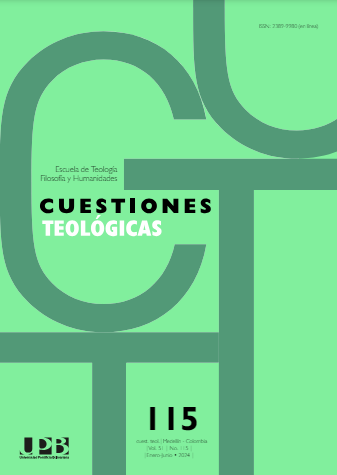Christian Life and Secularization in the First Centuries (III-V) and in the Last Ones (XVI-XXI)
Main Article Content
Abstract
The Roman Empire was radically transformed in the way it interpreted itself mentally, imaginatively and discursively between the third and fifth centuries of our era, thanks to the influence of the Christian life proposed by the Church. The Western societies that inherited and assumed that transformation have suffered, in turn, in the last centuries (XVI-XXI) another radical transformation in the way of interpreting themselves from their social imaginary, due to the loss of social influence of the Church. In the first case it is a process of de-secularization, in the second of secularization. This research proposes a reflection on this fact from two key concepts: Christian life and secularization. Christian life is that in which decisions are made based on Christian revelation oriented towards transforming union in God through love; it implies a transcendent, metahistorical and eschatological sense of existence. Secularization is the process that has led to the progressive disappearance of Christian life in the social imaginary of societies of ancient Christian tradition. Thus, the proposed theme is developed in four parts: (1) presentation of the Roman religion and (2) how Christianity de-secularized it, and then (3) the current secularization process and (4) its influence on Christian life
References
Auffarth, Ch. (2021). Religion and Classical Europe, Twelfth Century BCE – 600 CE. In G. Davie and L. N. Leustean (Eds.). The Oxford Handbook of Religion and Europe (pp. 21-37). Oxford: Oxford University Press.
Bloch, H. (1975). La rinascita pagana in Occidente alla fine del secolo IV. In A. Momigliano (Ed.). Il conflitto tra paganesimo e cristianesimo nel secolo IV (pp. 199-224). Torino: Einaudi.
Boyer, R. (2001). Le religioni dei germani, degli slavi, dei balti e dei celti. In F. Lenoir and Y. Tardan-Masquelier (Eds.). La religione. 1. La storia. Preistoria. Vicino Oriente antico. Mondo classico. Ebraismo (pp. 337-349). Torino: UTET.
Brown, P. (2012). El mundo de la antigüedad tardía. Prólogo de José Enrique Ruiz-Domènec (A. Piñero, Trad.). Madrid: Gredos.
Campanile, E. (1995). La religione dei germani. In G. Filoramo (Ed.). Storia delle religioni. 1. Le religione antiche (pp. 635-665). Bari: Editori Laterza.
Cancik, H. (1995). La religione romana.In G. Filoramo (Ed.). Storia delle religioni. 1. Le religione antiche (pp. 351- 408). Bari: Editori Laterza.
Cecconi, G. A. (2022). Barbari e pagani. Religione e società in Europa nel tardoantico. Bari, Roma: Editori Laterza.
Chuvin, P. (2012). Cronaca degli ultimi pagani. La scomparsa del paganesimo nell’impero romano tra Costantino e Giustiniano. Torino: Paideia
De la Cruz, J. (1998). Subida al Monte Carmelo. En Obras completas (pp. 160-527). Burgos: Monte Carmelo.
Markus, R. A. (1990). The End of Ancient Christianity. Cambridge: Cambridge University Press.
McGinn, B. (1999). The Presence of God. A History of Western Christian Mysticism. 1. The Foundation of Mysticism. Origins to the Fifth Century. New York: Crossroad.
Meslin, M. (2000). Romana, Religione. In P. Poupard (Ed.). Grande Dizionario delle Religione. Dalla preistoria ad oggi (Vol. 2. M-Z, pp. 1832-1836). Casale Monferrato: Edizioni Piemme.
Meslin, M. (2001). I culti orientali nel mondo romano. In F. Lenoir and Y. Tardan-Masquelier (Eds.). La religione. 1. La storia. Preistoria. Vicino Oriente antico. Mondo classico. Ebraismo (pp. 307-318). Torino: UTET.
Meslin, M. (2001a). L’evoluzione della religione romana (II-IV Sec. d. C.). In F. Lenoir and Y. Tardan-Masquelier (Eds.). La religione. 1. La storia. Preistoria. Vicino Oriente antico. Mondo classico. Ebraismo (pp. 305-306). Torino: UTET.
Momigliano, A. (1963). Introduction. Christianity and the Decline of the Roman Empire. In A. Momigliano (Ed.). The Conflict between Paganism and Christianity, in the Fourth Century (pp. 1-16). Oxford: Clarendon Press.
Momigliano, A. (2002). Romani, religione dei. Il periodo imperiale. In M. Eliade (Ed.). Enciclopedia delle Religioni. 11. Religioni del Mediterraneo e del vicino oriente antico (pp. 494-505). Milano, Roma: Jaca Book, Città Nuova.
Porte, D. (2001). La religione romana tradizionale (II sec. a.C. – II sec. d.C.). In F. Lenoir and Y. Tardan-Masquelier (Eds.). La religione. 1. La storia. Preistoria. Vicino Oriente antico. Mondo classico. Ebraismo (pp. 277-304). Torino: UTET.
Ries, J. (2000). Germani e Scandinavi, Religioni degli antichi. In P. Poupad (Ed.). Grande Dizionario delle Religione. Dalla preistoria ad oggi (Vol. 1. A-L, pp. 760-771). Casale Monferrato: Edizioni Piemme.
Rinaldi, G. (2020). Pagani e cristiani. La storia di un conflitto (secoli I-IV). Città di Castello (PG): Carocci Editore.
Santangelo, F. (2022). La religione dei romani. Bari: Editori Laterza.
Simonetti, M. (2001). Cristianesimo antico e cultura greca. Roma: Borla.
Tacey, D. (2004). The Spirituality Revolution. The Emergence of Contemporary Spirituality. Hove, New York: BrunnerRoutledge.
Taylor, Ch. (2009). La età secolare. Roma: Feltrinelli.
Zas Friz De Col, R. (2019). The Transforming Presence of Mystery. A Prospective of Spiritual Theology. Leuven, Paris, nBristol (CT): Peeters.
Zas Friz De Col, R. (2020). “La parola parla sempre in eterno silenzio”. L’approccio di San Giovanni della Croce. In nB. Aniello and D. Kowalcyk (Eds.). Silenzio, polifonia di Dio (pp. 133-147). Roma: G&B Press.
Zas Friz De Col, R., (2021). La relación entre espiritualidad y teología desde la relación entre lo vivido y lo pensado. Perspectiva Teológica, 53(2), 325-352






